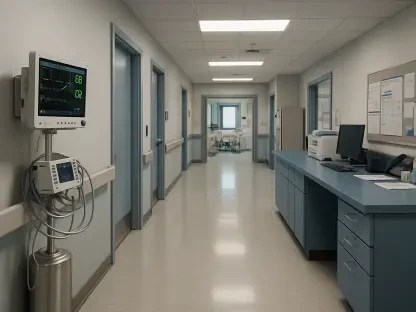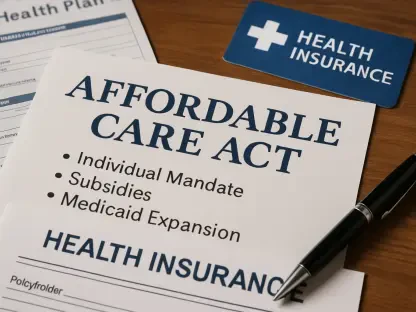In the heart of California’s San Joaquin Valley, a financial storm is brewing for nearly 185,000 lower-income residents who rely on enhanced tax credits to afford health insurance through Covered California, and these subsidies, introduced as part of COVID-era relief legislation, have been a critical buffer. They have kept monthly premiums manageable for families across the region and for roughly 2 million people statewide. However, with these credits set to expire by the end of 2023, the absence of congressional action could trigger a catastrophic doubling—or in some cases, quadrupling—of premium costs, pushing many into the ranks of the uninsured. This looming crisis not only threatens individual households but also risks undoing years of progress in expanding health coverage across the state. As political gridlock stalls solutions in Washington, the clock is ticking, with Covered California forced to delay renewal notices in a desperate hope for resolution. The stakes couldn’t be higher for a region already grappling with economic challenges and limited access to affordable care.
The Financial Fallout of Expiring Credits
Premium Spikes and Household Impact
The potential expiration of enhanced tax credits under Covered California paints a grim picture for San Joaquin Valley families, with monthly health insurance premiums poised to skyrocket in the absence of federal subsidies. Projections indicate that most Valley counties could see increases exceeding 100%, with Merced County facing a staggering 388% hike. For many middle- and lower-income households, this translates to premiums jumping from as low as $24 a month to over $500, a burden that could force tough choices between coverage and basic necessities. These credits, which cap premium costs at 8.5% of household income for eligible enrollees, have been instrumental in making insurance accessible to those earning above 400% of the federal poverty level. Without them, the financial strain could push thousands out of the marketplace entirely, leaving them vulnerable to medical emergencies without a safety net. The immediate impact on family budgets is undeniable, as the cost of maintaining coverage becomes an unattainable luxury for many.
Beyond the raw numbers, the human toll of these premium spikes reveals a deeper crisis for Valley residents already stretched thin by economic pressures. Small business owners and gig workers, who often lack employer-sponsored plans, stand to lose the most, as their incomes fluctuate and savings are limited. A single month’s premium at unsubsidized rates could consume a significant portion of their earnings, leading to impossible trade-offs. Reports suggest that even a temporary lapse in coverage could result in delayed medical care, exacerbating chronic conditions and piling on future costs. The fear of “sticker shock” from renewal notices looms large, as families brace for rates that reflect the loss of subsidies. This financial upheaval threatens not just individual health but the stability of entire communities, where access to affordable insurance has been a hard-won achievement over recent years.
Budgetary Strain and Coverage Losses
The cascading effect of expiring tax credits extends beyond premium increases, placing unprecedented strain on household budgets across the San Joaquin Valley. For the 91% of the region’s 202,000 Covered California enrollees who depend on subsidies, the loss of this support could mean monthly costs rivaling rent or mortgage payments. In counties like Stanislaus, where subsidized premiums average $113, unsubsidized rates could climb to over $700, an amount simply out of reach for many. This drastic shift risks creating a domino effect, where families cut corners on preventive care or drop coverage altogether to manage expenses. The resulting gaps in insurance could lead to untreated health issues, ultimately burdening emergency services and public health systems with higher costs down the line. The financial pressure is a stark reminder of how fragile affordability remains for so many in this region.
Moreover, the potential for widespread coverage losses adds another layer of urgency to the situation, as the Valley grapples with the fallout of unaffordable insurance. Data from health policy experts indicate that healthier individuals are likely to forgo coverage when costs surge, leaving a sicker, more expensive pool of insured individuals behind. This imbalance drives up premiums even further, creating a vicious cycle that could destabilize the entire marketplace. For households already living paycheck to paycheck, the loss of subsidies isn’t just a numbers game—it’s a direct threat to their ability to access care. The broader economic implications are equally concerning, as reduced coverage correlates with lower productivity and increased absenteeism among workers. The ripple effects of this budgetary crisis could reshape the region’s health landscape for years to come.
Political Stalemate in Congress
Gridlock and Government Shutdown
At the core of the health insurance crisis in the San Joaquin Valley lies a bitter partisan deadlock in Congress, where the extension of enhanced tax credits has become a contentious battleground with no clear resolution in sight. This disagreement contributed to a federal government shutdown on October 1, halting critical discussions and leaving millions of Covered California enrollees in limbo. Republicans and Democrats remain at odds over the funding and scope of these subsidies, with little indication of compromise despite the mounting consequences for American families. The shutdown has amplified the uncertainty, as federal agencies grind to a halt and legislative progress stalls. For Valley residents, this political inertia translates to real-world anxiety, as the affordability of their health coverage hangs in the balance while lawmakers debate in Washington.
The timing of this gridlock could not be worse, with Covered California delaying renewal notices until October 15 in a last-ditch effort to await congressional action. Without a decision by that deadline, notices will reflect unsubsidized, sky-high premium rates, potentially triggering immediate coverage drop-offs due to cost concerns. Jessica Altman, executive director of Covered California, has expressed cautious hope for a resolution but acknowledges the lack of confidence in a timely outcome. This delay in communication risks sowing confusion among enrollees, many of whom may not fully grasp the political machinations behind their rising costs. The government shutdown serves as a stark backdrop to the urgency of the situation, underscoring how far-reaching policy disputes can directly impact the lives of ordinary citizens in regions like the Valley.
Delayed Decisions and Public Frustration
The prolonged indecision in Congress has left Covered California in a precarious position, forced to navigate uncharted territory as it postpones critical updates to enrollees about their 2024 premiums. This delay, while intended to buy time for a potential subsidy extension, risks creating a wave of frustration and mistrust among Valley residents who rely on clear, timely information to plan their finances. When renewal notices finally arrive, the likelihood of significantly higher rates could lead to widespread disillusionment, even if relief comes later. The psychological impact of this uncertainty cannot be overstated, as families grapple with the fear of losing affordable coverage while political leaders remain gridlocked. This situation highlights a disconnect between policy debates and the real-time needs of constituents facing immediate financial pressures.
Public frustration is mounting as the federal shutdown drags on, with little transparency about when or if a resolution will emerge to preserve these vital tax credits. For many in the San Joaquin Valley, the sense of being caught in a political crossfire is palpable, as their access to health care becomes a bargaining chip in broader fiscal negotiations. Advocacy groups and local leaders have begun to voice concerns over the lack of urgency in addressing this crisis, pointing to the tangible harm caused by delayed decisions. The longer Congress waits to act, the greater the risk of irreversible damage, as enrollees may abandon coverage before any retroactive relief can take effect. This growing discontent reflects a broader erosion of faith in the system’s ability to protect vulnerable populations during times of crisis.
Vulnerable Populations at Risk
Disproportionate Burden on the Valley
The San Joaquin Valley, already burdened by higher-than-average uninsured rates, stands to bear a disproportionate share of the fallout if enhanced tax credits for health insurance expire without renewal. With over 291,000 residents currently uninsured, representing 5% to 8.2% of county populations, the region is ill-equipped to absorb additional coverage losses. Around 91% of the 202,000 local Covered California enrollees depend on subsidies, paying manageable premiums as low as $24 monthly in areas like Merced County. Losing this support could push costs beyond $500 a month, an insurmountable barrier for many low- and middle-income families. The Valley’s economic challenges, including limited access to employer-sponsored plans, amplify the severity of this threat, leaving entire communities at risk of falling through the cracks of the health care system.
Specific groups within the Valley face heightened vulnerability, particularly small business owners, gig economy workers, farmers, and agricultural laborers who form the backbone of the region’s economy. These individuals often lack the safety net of traditional employment benefits, relying heavily on marketplace plans to secure coverage. Nationwide, over one in four farmers depend on such plans, a statistic that resonates deeply in an agricultural hub like the Valley. The loss of subsidies could force these workers to forgo insurance, risking their health and financial stability in the face of injury or illness. This demographic reality underscores how the expiration of credits threatens not just individual well-being but also the economic vitality of a region dependent on these essential contributors.
Economic Diversity and Health Disparities
The diversity of those affected by the potential loss of tax credits in the San Joaquin Valley reveals a complex web of economic and social challenges that cut across traditional assumptions about the uninsured. Contrary to common stereotypes, nearly 102,000 uninsured residents in the region work full-time, year-round jobs, demonstrating that lack of coverage isn’t solely tied to unemployment. From seasonal laborers to self-employed entrepreneurs, the spectrum of affected individuals highlights the structural gaps in the U.S. health care system, where employer-based insurance remains out of reach for many. The expiration of subsidies risks widening these gaps, pushing even more working families into financial distress as they struggle to afford premiums that could consume a significant portion of their income.
Health disparities, already a pressing concern in the Valley, are poised to deepen if affordable coverage slips away from vulnerable populations. The region’s existing uninsured often delay medical care due to cost, leading to worse health outcomes and higher rates of preventable hospitalizations. Adding to this pool of uninsured individuals through subsidy loss could exacerbate these trends, placing additional strain on local clinics and emergency rooms. Rural areas, where access to providers is already limited, face an even graver risk, as residents may forgo preventive services entirely. The intersection of economic diversity and health inequity paints a troubling picture, where the loss of tax credits could entrench systemic barriers to care for generations to come.
Systemic Consequences for Health Care
Rising Uninsured Rates and Long-Term Costs
The expiration of enhanced tax credits under Covered California threatens to reverse California’s hard-earned progress in reducing its uninsured rate to historic lows, with profound implications for the San Joaquin Valley and beyond. Statewide, 2.3 million residents already lack coverage, and in the Valley alone, over 291,000 individuals are uninsured. Losing subsidies could swell these numbers significantly, as families opt out of unaffordable plans, undermining years of expansion under the Affordable Care Act. This surge in the uninsured population risks overwhelming public health resources, as emergency rooms become the default care provider for those without insurance. The long-term costs of untreated conditions and delayed care could burden taxpayers and health systems alike, creating a fiscal challenge that extends far beyond individual households.
Furthermore, the systemic impact of rising uninsured rates includes a dangerous feedback loop in the insurance marketplace, as healthier enrollees drop coverage due to cost. This leaves a riskier, sicker pool of insured individuals, driving up premiums for everyone—a phenomenon warned about by Covered California’s executive director, Jessica Altman. The resulting cost spiral could destabilize the state’s health insurance framework, making coverage even less attainable for those who remain. Beyond economics, the health consequences are stark: studies show the uninsured are less likely to seek regular medical care, leading to poorer outcomes and higher mortality rates for preventable conditions. The Valley, with its existing disparities, stands to suffer most acutely from this unraveling of access to care.
Strain on Public Health and Future Challenges
The potential influx of uninsured residents in the San Joaquin Valley due to expiring tax credits places an immense strain on public health infrastructure, which is already stretched thin in many rural and underserved areas. Community clinics and hospital emergency departments, often the last resort for those without coverage, could face unsustainable demand as more individuals forgo preventive care and seek treatment only in crisis. This shift not only compromises patient outcomes but also inflates health care expenditures, as treating advanced conditions costs far more than early intervention. Local governments and health organizations may struggle to allocate resources effectively, risking a decline in overall community well-being as preventable diseases and chronic illnesses go unchecked.
Looking ahead, the challenges posed by this crisis extend into future policy and economic considerations, demanding proactive measures to mitigate long-term damage. Even if Congress eventually extends the tax credits, the interim period of uncertainty and higher premium notices could cause irreversible coverage losses, as families abandon plans before relief is implemented. Addressing this requires not only swift legislative action but also robust outreach to educate enrollees about potential retroactive support. Additionally, policymakers must consider the broader trend of rising health care costs, with a projected 10.3% increase in base premiums due to escalating medical and drug expenses. Combining this with subsidy loss creates a “double whammy” effect, necessitating innovative solutions to ensure access to care remains a priority for vulnerable regions like the Valley.









